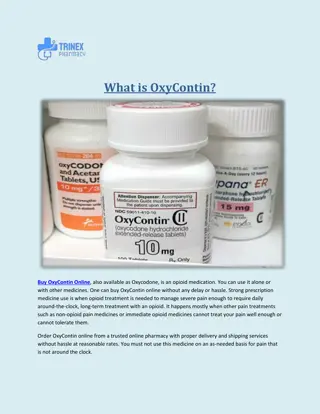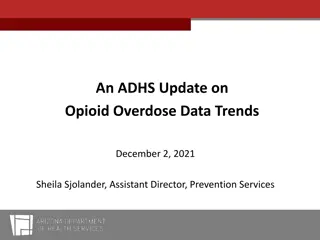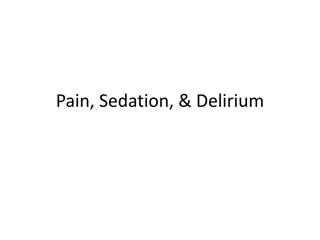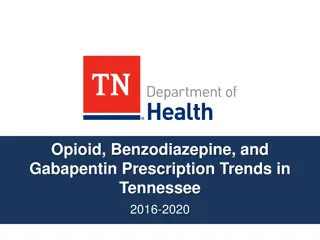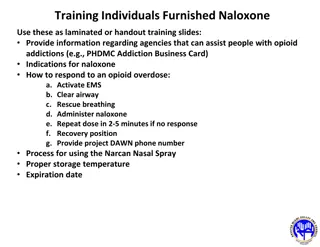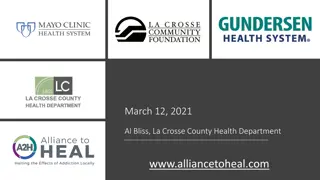Enhancing Patient Safety: Introducing the Pasero Opioid-Induced Sedation Scale
Sedation and respiratory depression are common issues with opioids. Monitoring patients using the Pasero Opioid-Induced Sedation Scale is crucial for patient safety. This scale helps in assessing sedation levels and taking timely action to prevent complications, ultimately improving the quality of patient care.
Download Presentation

Please find below an Image/Link to download the presentation.
The content on the website is provided AS IS for your information and personal use only. It may not be sold, licensed, or shared on other websites without obtaining consent from the author.If you encounter any issues during the download, it is possible that the publisher has removed the file from their server.
You are allowed to download the files provided on this website for personal or commercial use, subject to the condition that they are used lawfully. All files are the property of their respective owners.
The content on the website is provided AS IS for your information and personal use only. It may not be sold, licensed, or shared on other websites without obtaining consent from the author.
E N D
Presentation Transcript
POSS, Introducing the Pasero Opioid- Induced Sedation Scale! Level of Sedation Monitoring A patient safety initiative Sedation, followed by respiratory depression, is a common side effect of opioid administration. Evidence strongly indicates that monitoring patients level of sedation while on opioids reduces the incidence of related adverse events. RNs will receive 0.5 CE for completion of this program. SLUHN 2014-2015
Please view this program in Slide Show format. POSS = Level of Sedation Monitoring
Program Objectives Define POSS vs RASS Describe Policy Changes POSS = Level of Sedation Monitoring Explain Practice Expectations and Practical Application
Why? Prevent/minimize complications or adverse events while providing the best possible pain management for patients. The Joint Commission sentinel event alert recommendation: Provide standardized tools that can be used to screen patients for risk factors associated with oversedation and respiratory depression during opioid administration. POSS = Level of Sedation Monitoring Health care providers play a major role in preventing life- threatening respiratory depression through sedation assessments and appropriate decision making during opioid administration.
Define POSS vs RASS What are they? POSS = Pasero Opioid Induced Sedation Scale The POSS tool was developed by Chris Pasero and is used to detect and prevent/minimize clinically significant opioid induced sedation and respiratory depression.
Define POSS vs RASS What are they? POSS = Pasero Opioid Induced Sedation Scale POSS is a standardized tool used by RNs to assess patients for level of sedation while receiving opioids for pain management. POSS is used to guide interventions based on level of sedation. POSS will not be used for end-of-life patients receiving opioids for pain management.
Define POSS vs RASS What are they? An important difference between POSS and RASS is that the RASS tool is used for PURPOSEFUL or GOAL- DIRECTED sedation unlike the POSS tool which is trying to prevent oversedation. RASS = Richmond Agitation Sedation Scale A standardized tool used by RNs to assess patients for level of sedation, agitation, and anxiety while receiving purposeful or goal-directed sedation. RASS is primarily used in the critical care environment.
POSS ACTIONS/ INTERVENTIONS RATING/CRITERIA Acceptable no action necessary, prescriber may increase opioid dose if needed S = Sleeping, easy to arouse The POSS Tool Acceptable no action necessary, prescriber may increase opioid dose if needed 1 = Awake and alert Acceptable no action necessary, prescriber may increase opioid dose if needed 2 = Slightly drowsy, easily aroused Unacceptable -Acute care-notify prescriber-expect decrease in opioid dose -Critical Care/PACU-consider notifying prescriber -Prescriber to consider ordering a non-opioid such as acetaminophen or an NSAID, if not contraindicated -Monitor respiratory status (including oxygen saturation) and sedation level every 15 minutes until patient returns to acceptable level -Ask patient to take deep breaths every 15 minutes 3 = Frequently drowsy, arousable, drifts off to sleep during conversation An important aspect of the POSS tool is the actions/interventions provided so the RN can react quickly when necessary to prevent patient harm and adverse events Unacceptable -Stop opioids if continuous infusion, do not administer additional opioids -Notify prescriber-anticipate need for Naloxone Consider calling rapid response team -Stay with patient -Stimulate and support respirations as indicated by patient status, e.g. bag mask -Monitor respiratory status and sedation level continuously until sedation level is stable to acceptable level and respiratory status is satisfactory 4 = Somnolent, minimal or no response to verbal and physical stimulation
Describe Policy Changes What do I need to know? NOTE: In the PACU, pain scores and POSS scores will be documented every 15 minutes. If pain is present, a POSS score will be obtained along with the pain assessment when opioids will be administered - this provides a baseline assessment of patient pre-intervention. When pain is reassessed following opioid administration, the patient s level of sedation will be assessed using POSS. POSS scores will be documented with pre-intervention and post-intervention pain scores when opioids are administered.
Describe Policy Changes What do I need to know? What about PCA Pump and Epidural assessments? The POSS tool will provide a standard way to assess level of sedation for patients receiving PCA Pump and Epidural therapy.
Identify Practice Expectations How will I apply this to my practice? Incorporating the POSS tool in practice will: Provide a mechanism to more rapidly detect incremental changes in sedation. Facilitate RN decision making and safer administration of opioids. Provide a standardized mechanism to communicate and document patient level of sedation.
Identify Practice Expectations How will I apply this to my practice? An important question When is the post-intervention assessment performed (pain and POSS scores)? Opioid Type Route Frequency Sedation Monitoring via POSS IV, IM Onset: ~ 5 min. Peak: 10-20 min. PRN or Scheduled Before administration and approx. 15-30 min. post administration with pain reassessment Immediate Release PO, SQ, PR Onset: 15-30 min. Peak: 30-60 min. PRN or Scheduled Before administration and approx. 60 min. post administration with pain reassessment Immediate Release PO, Transdermal Peak: Hours (varies with each medication) Scheduled Before administration and with pain reassessment(s) SR
Identify Practice Expectations How will I apply this to my practice? What if the patient is sleeping at the time of the post-intervention assessment? If the patient is sleeping and pain has been well managed without occurrence of sedation levels (POSS score) 3 or 4, the RN may document sleeping, easy to arouse if respirations are quiet, regular, deep and rate > 10/minute and light touching of the patient s shoulder or gentle movement of the bed results in patient movement or change in position. If the respiratory rate is less than or equal to 10 or respirations are irregular, shallow, or noisy (even mild snoring) and/or the patient does not change position or demonstrate movement in response to light touching of the patient s shoulder or gentle moving of the bed, wake the patient and perform a pain assessment and level of sedation assessment (POSS score).
Identify Practice Expectations How will I apply this to my practice? One last practice expectation For patients on opioid therapy, consider monitoring level of sedation using POSS scale criteria with each and every patient interaction. This practice will help identify any potential complications and/or adverse events quickly and prior to any patient harm.
Practical Application Let s make this real Opioid Induced Respiratory Depression (OIRD) Up to 1/3 of code-blue arrests in the hospital are due to OIRD1 Traditional estimates OIRD in post-operative setting occurs in 1 - 15% of patients receiving opioids2,3 More recent data shows incidence MORE COMMON1: 58% post-operative patients had low RR for at least two minutes 21% had low Sa02 for two minutes Conclusion: OIRD more common than previously thought 1: Overdyk FJ, et al. Anesth Analg. 2007; 105(2): 412-18. 2: Cashman JN, Dolin SJ. J Anaesth. 2005; 93: 212-23. 3: Walder B, et al. Acta Anesthesiol Scand. 2001; 45: 795-804. 4: Taenzer AH, et al. Anesth Analg. 2014; 118(2): 326-331.
Practical Application Rapidly Evolving Clinical Cascades (RECCs) RECCs are unexpected, often deadly, adverse clinical events that develop subtly at first or are disguised by sleep, followed by rapid clinical deterioration. RECCs evolve over time with subtle early signs and late precipitous decompensation. Three classic patterns of RECCs exist, two of which are associated with opioid administration and are more likely to be found in post-operative patients
Practical Application Rapidly Evolving Clinical Cascades (RECCs) Class I Medical condition causing SOB Causes: pneumonia, CHF, Aspiration, Sepsis Signs/Symptoms: Early: complaints of SOB/dyspnea; increased RR; normal or mildly low Sa02 Late: desaturation; change in mental status; hypoxemia Treatment: FIND UNDERLYING CAUSE Do not just treat SOB with oxygen something is causing dyspnea. Diagnose it!
Practical Application Rapidly Evolving Clinical Cascades (RECCs) Class II CO2 narcosis Causes: sedation/narcosis induces hypercapnia Signs/Symptoms: Early: somnolence, with or without obstructive breathing patterns; decreased RR; normal or mildly low SaO2 Late: inability to awake (due to hypercapnia); hypoxemia Treatment: Reverse sedation (naloxone, flumazenil) Do not let sleepy patients with low RR lie. Awake to assess!
Practical Application Rapidly Evolving Clinical Cascades (RECCs) Class III Arousal failure in patient with obstructive sleep apnea (OSA) Causes: sedated patient with OSA obstructs and fails to arouse Signs/Symptoms: Early: patient visibly obstructs and desaturates during sleep; RR may be normal; CO2 may be normal Late: patient found unresponsive and severely hypoxemic Treatment: Needs immediate rapid response/code call Prevention: CPAP 5: Curry JP, Jungquist CR. A critical assessment of monitoring practices, patient deterioration, and alarm fatigue on inpatient wards: a review. Patient Safety in Surgery.2014(8): 29.
Practice Expectations & Application Don t forget POSS will help identify potential complications related to opioid use and facilitate RN decision making. POSS will provide a mechanism to more rapidly detect changes in level of sedation (Rapidly Evolving Clinical Cascades) particularly for patients receiving opioids. POSS = Level of Sedation Monitoring Overall, POSS will facilitate safer administration of opioids.
Practice Expectations Stay tuned for the Level of Sedation Monitoring pocket reference card. The card will include the POSS tool, table with timing of assessments, and other practice tips. Refer to the SLUHN Pain Management [D-23] policy which includes all pertinent information. The newly revised policy will be available in the Nursing Policy & Procedure Manual on MyNET during the go-live week of January 19th, 2015.
Please proceed to the posttest to validate what you have learned from this program. RNs will receive 0.5 CE for completion of the program. Don t forget to print the certificate for your records. POSS = Level of Sedation Monitoring Thank you for being an integral part of this very important patient safety initiative! Program created by the POSS development team with assistance from Christopher R. Roscher, M.D., Anesthesia Specialists of Bethlehem, SLUHN. SLUHN 2014 - 2015






